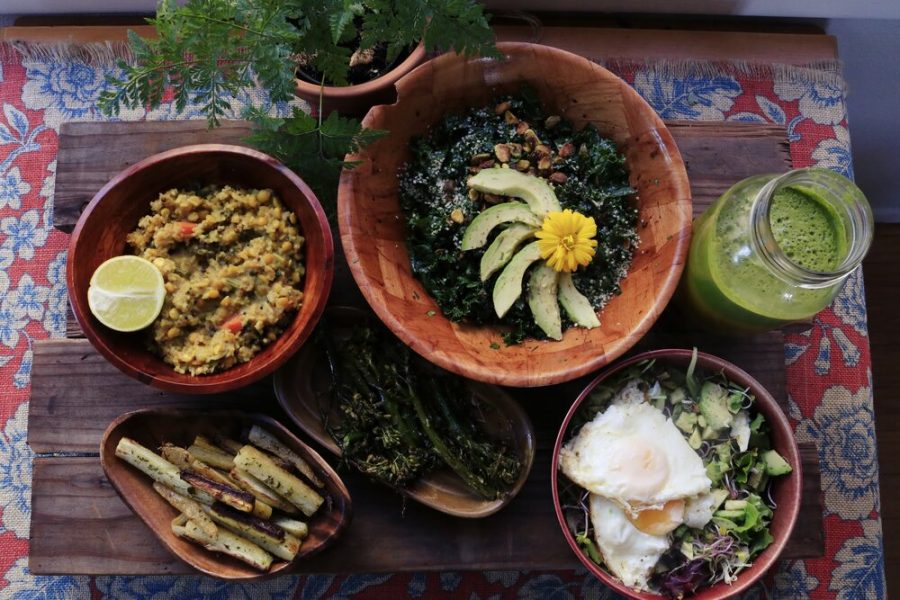
Yoga is an ancient yoga practise that originated in India. For years, yoga was only practised by the most advanced yogis. Today, yoga has become more mainstream and can be done by anyone with time to spare for it.
Yoga offers many benefits; some of which include reducing stress levels and lengthening your life! In this post, we will explore what a yoga diet looks like and what you should know before starting one.
So, what is a yoga diet?
Combining your yoga practice into your eating habits isn’t as straightforward as you might think. Especially since the ancient yogic texts such as Patanjali’s Yoga Sutra and the Bhagavad Gita do not mention any specific yoga diet.
However, there is a way of eating that has been practised for thousands of years in ancient India and is followed by many yogis – an Ayurvedic diet.
This is a way of eating based on the teachings of Ayurvedic medicine, a type of traditional medicine dating back thousands of years. Let’s explore the ayurvedic diet.
An introduction to Ayurveda
Ayurveda has been around since the time of Vedic scriptures. It is a rational form of medicine that incorporates herbal medication, yoga and dietary modification to treat disease and promote health.
Ayurveda has been around for thousands of years in India. It involves combining nutrition with lifestyle changes like yoga practice and mindfulness to help people stay healthy or get better from illness.
Ayurveda literally translates into ‘the knowledge of life’. The word can be seen in ancient Hindu texts known as Vedas which date back more than 5000 years.
The word “Ayurveda” comes from two Sanskrit words: Ayus meaning lifespan, vitality; and Veda meaning wisdom or science. So literally, Ayurveda means the science of life and longevity.
Ayurveda is a holistic way to look at health – it doesn’t just focus on treating illness but also on preventing it. By understanding your body and its needs, you can create a lifestyle for yourself that is healthier and happier.
Find your dosha
The primary feature of an Ayurvedic or yoga diet is that you eat according to your dominant constitutional type, or dosha. The three doshas are Vata, Pitta, and Kapha. When you eat according to your dominant dosha, it helps keep the body in balance.
You can either visit an Ayurvedic doctor who will help you find the best foods to eat according to your dominant dosha. If you can’t attend an Ayurvedic doctor, you can also complete an online quiz.
What to eat on a yoga diet
Regardless of your dosha type, the Ayurvedic diet recommends eating foods that are conducive to health and avoiding those which cause harm. This includes staying away from processed food, fast food, junk food and anything packed with preservatives or artificial flavours and additives.
Foods included in an Ayurvedic diet would be fresh vegetables (especially leafy greens), rice, whole grains and beans.
What foods are avoided in the Ayurvedic diet?
Some of what is to be avoided on an Ayurvedic include caffeine, dairy products, gluten-containing food like bread and pasta and red meat.
This type of diet is not vegan nor vegetarian, but it does encourage eating less protein than many other diets out there.
Something that can also benefit those with kidney problems or liver disease.
Principles of a yogic diet
If you’re interested in following a yoga diet, it’s recommended to follow these Ayurvedic principles when it comes to eating:
-
A total of six rasas or tastes must be consumed on a daily basis. Combine flavours that are sweet, salty, sour, bitter, pungent, and astringent at each meal.
-
Sweet-tasting foods (such as fruit) should be the first thing you eat during your meal.
-
Continue with salty and sour tasting foods (such as fish),
-
Finish with pungent (as in onions or peppers), astringent (such as green apples or tea), and bittersweet (such as celery, kale, or green leafy vegetables) ingredients.
-
Take time to enjoy your meal. Avoid talking, laughing, and other distractions to fully enjoy your food and the health advantages it provides.
-
Take your time and eat slowly enough that you can enjoy the food (but not so slow that your food gets cold)
-
Make sure you eat enough calories. Appreciate the importance of hunger signals and indications of fullness to prevent overeating.
-
Only consume when your last meal has been completely digested. You should not eat anything for at least three hours after your previous meal or snack. Do not go without food for more than six hours.
-
Concentrate on breakfast and lunch. Many Ayurvedic practitioners and yogis advocate for a modest breakfast and a substantial, satiating lunch. Based on your hunger levels, dinner may or may not be consumed.
Foods to eat based on your dosha
The foods you will need to buy will depend on your dosha type, as well as how closely you follow Ayurvedic principles.
Below is a sample of foods to eat and avoid based on your dosha.
Vata
Vata is cold, dry, harsh, and light. To balance excessive Vata, eat meals with the opposite characteristics. Choose meals that are warm, moist, oily, smooth, and nourishing.
Foods to eat:
-
Warm or hot fluids like soups or stews
-
Avocados, coconut, olives, buttermilk, cheese, eggs, whole milk, wheat flour products like bread and waffles (wheat gluten), nuts/seeds/berries and dairy
-
Fruits like green grapes, oranges and pineapple in small quantities
-
Eat vegetables but they should be well-cooked, garnished with ghee or coconut oil
Foods to avoid
-
Apples, melons, and other cold or frozen meals
-
Dry fruits and foods like popcorn, beans, crackers, grains like barley, buckwheat, couscous and millet
-
Raw or dried vegetables, potatoes, barley, corn, chickpeas, split peas, yogurt, lamb, turkey, red wine, and chocolate.
-
Limit your intake of stimulants like caffeine and tobacco
Pitta
The Pitta dosha is oily, sharp, hot, and light. Eating foods that have the opposite qualities can help to balance excess pitta. Choose foods that are mild, cooling, grounding, stabilizing, and dense.
Foods to eat
-
Vegetables like asparagus, cucumbers, celery, okra, lettuce, green beans sweet potatoes, leafy greens, pumpkins, broccoli, cauliflower and zucchini.
-
Grains like wheat, white rice, barley and oats also helps to balance pitta.
-
Meats like turkey, chicken should be consumed in moderation.
-
Consume fruits like grapes, mango, pomegranate, pineapple, oranges, melon, cherries, coconut, avocado and plums.
-
Use soothing spices in cooking like coriander, cardamom, saffron and fennel seeds.
Foods to avoid
-
Spicy foods, such as chilli peppers, paprika and dried chilli flakes. These include spices like ginger and garlic.
-
Onions, tomatoes, hot peppers, carrots, beets, eggplant or raw leeks, soy sauce, salted butter, eggs, seafood and sour cream
-
Ginger, cumin, black pepper, fenugreek, chilli pepper, cayenne and cloves should be avoided
Kapha
Kapha is based on earth and water. This dosha can be described as steady, stable, heavy, slow, cold, and soft.
Foods to eat
-
Vegetables like asparagus, cucumbers, celery, lettuce, green beans sweet potatoes, leafy greens, pumpkins, broccoli, cauliflower and zucchini
-
Grains such as wheat, rice, barley, and oats assist to balance pitta.
-
Turkey and chicken should be eaten in moderation, as should other meats.
-
Consume grapes, mango, pomegranate, pineapple, oranges, honeydew melon, cherries, coconut milk and avocados.
-
Soothing spices, like coriander, cardamom, saffron, and fennel seeds
Foods to avoid
-
Sweet or acidic fruits such as oranges, bananas, avocados, pineapples, peaches, melons, dates, grapefruit and figs
-
Sweet or juicy vegetables like tomatoes, cucumber or zucchini
-
Oats, pasta, pancakes, rice, wheat, kidney beans, soft or hard cheese, fish, ketchup, alcohol and chocolate
Sample yoga diet meal plan
Below is an example of an Ayurvedic day of eating. Keep in mind that this will differ from person to person:
Breakfast: A morning smoothie with kale, banana and almond milk.
Lunch: Vegetable soup (you can make it vegetarian or vegan) served over brown rice.
Dinner: Lentil curry with cauliflower and broccoli topped off with some avocado on the side. Add a little extra virgin olive oil to your meal if you need more fat for dinner time digestion
Yoga Diet FAQs
What do yogis eat in a day?
Yogis typically follow a plant-based, whole food diet that includes lots of fruits and veggies. The main staples in the daily diets of many yogis are fresh juice, smoothies, salads, beans/legumes (including sprouted grains), and various cultured foods.
How many meals a day do yogis eat?
When it comes to maintaining a yoga diet, you should eat at regular intervals throughout the day. A 3-meal-per-day regimen with midmorning and evening snacks is a good place to start. Always eat two hours before asana (or any other type of yoga practice), and at least two hours before going to bed.
Do yogis need less food?
In general, no. The amount of calories your body needs depends on several factors, including your weight and activity level.
However, yogis who follow a vegetarian diet (no meat) may eat less, as it is much easier to avoid excess calories because they’re not consuming as many fatty foods like cheese or steak. They also try to stay away from processed carbohydrates such as white pasta and bread.
Which foods are sattvic?
A Sattvic diet is a completely vegetarian diet that includes seasonal fresh fruit, plenty of fresh vegetables, whole grain, pulses, sprouts, dried nuts and seeds, honey, fresh herbs and milk. These items improve our sattva or spiritual awareness levels
Try a yoga diet for yourself!
The ayurvedic diet is a way of eating that has been practised for thousands of years. While not the only type of yoga diet out there, it is a popular way of eating for many yogis.
This type of diet follows the teachings of Ayurveda medicine and can be an easy addition to your yoga practice – especially if you already have some knowledge about this ancient form of natural healing.
Try incorporating some of the Aryuvedic principles to your diet and let us know how you feel!



